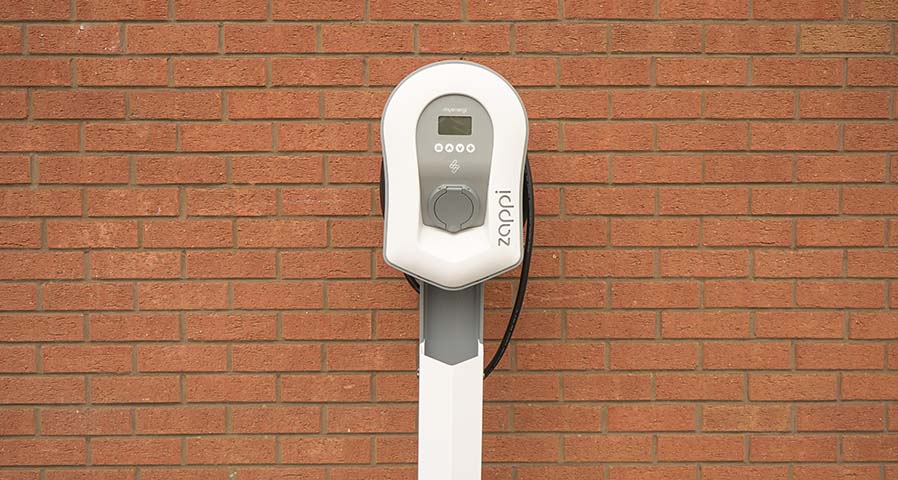The purpose of a PEV charger is to supply electricity to an EV from the power grid. Its placement depends on a few factors. Installing PEV charging equipment requires running a line between your electrical panel and the charging station. The unit also needs mounting and possibly network connectivity.
Here’s what you should know about PEV charger placement.
Selecting the Type of PEV Charger
Municipalities typically choose Level 2 chargers. The stations provide plenty of power to charge municipal fleet passenger vehicles. Some may select Level 1 units but typically only when fleet vehicles cover under 40 miles a day.
Municipalities with tight budgets may start with a Level 1 charger or provide a compatible outlet for the unit supplied with the vehicle. Even after installing and mounting the charger, it’s a relatively simple process to upgrade to a Level 2 unit at a later date.
It will depend on your initial installation permit and if more robust wiring is required to support the more powerful charger.
Number of PEV Chargers
In theory, it’s recommended to have a charging point for each fleet vehicle. It allows you to charge the entire fleet overnight. Some fleets have more vehicles than charging stations since their routes do not deplete the EVs range in a single day. What works best for your fleet depends on your budget and your charging needs.
However, it may make sense to install an additional electrical conduit and increase the panel capacity during the installation. It makes it easier to add more PEV chargers at a later date and will save time and money.
Type of Electrical Panel
When an EV is connected to a Level 2 charger, the vehicle uses 7000 W. To put it into perspective, 7000 W is what an electric stove uses with all four burners and the oven on. A powerful hairdryer uses around 1400 W.
The electrical load of a PEV charger is a significant consideration. The demand can increase your electrical bills, especially if the connected meter has only a few additional loads.
Apogee Charging Solutions offers several Level 2 PEV charging stations, ranging from 7.6 kw – 19.2 kw. You can browse our PEV level 2 chargers here, as well as download their spec sheets.
PEV Charger Distance from the Electrical Panel
The distance the PEV charger is from the electrical panel increases installation costs, especially if underground cables are necessary. Trenching is expensive and should be considered before choosing a location. Remember, you do not need to place the PEV charger near a door, especially if it increases the cost.
In-Ground or Wall Mounted
You can choose to mount PEV chargers on the wall or a pedestal. It is usually more cost-effective to install PEV charging units on the wall. Digging a hole for the pedestal can add to installation costs. You can often keep the electrical wires inside with wall-mounted units. With a pedestal, the cables are often extra.
When pedestal mounting is the only option, consider installing the PEV chargers on soft or grassy ground. You can save money by not having to dig up and replace the pavement.
Don’t forget about installing additional conduits so you can add more chargers as your fleet expands.
Inside or Outside a Fenced Area
Placing the PEV chargers inside the fence provides an extra layer of protection against theft and vandalism. It also limits unauthorized use that can increase your utility bills.
Another option is deciding to place the chargers in a private or public parking lot. Most municipalities choose private parking lots unless they are planning on charging the public for use of the stations.
Networked or Non-Networked Chargers
You can remotely monitor PEV chargers with networked hardware and software. It makes it easier for fleet managers to monitor the charger’s use. If you are planning on opening the charging stations to the public, networked units make it easier to set and track usage payments.
Networked PEV charging stations are more expensive. You also have to account for the software fees. Some municipalities decide that communications software is an unnecessary cost while others use it to simplify monitoring.
Public, Private, or Fleet Parking
Placement for PEV chargers often depends on the type of usage. Public chargers are often placed near doorways for convenience, while private stations are typically located near employee parking areas.
When PEV chargers are for fleet charging they are often not placed nearby doorways. Municipalities can select the location with the least expensive installation costs. Another option is to install the PEV chargers in an area easily visible to the public. It’s an effective way to advertise your business is concerned about the environment and sustainability.
For more information about PEV chargers, contact us today! Call 484-816-2076, emailing [email protected], or schedule a call that fits your needs by clicking the button below.








0 Comments